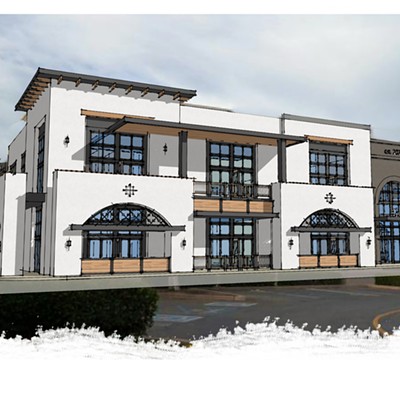A vibrant image from 2016 shows the corner where West Stowell Road and South Depot Street meet. But instead of the strawberry field that exists there now, the design shows a bustling park with six regulation-sized soccer fields at its center, and another junior-sized field.
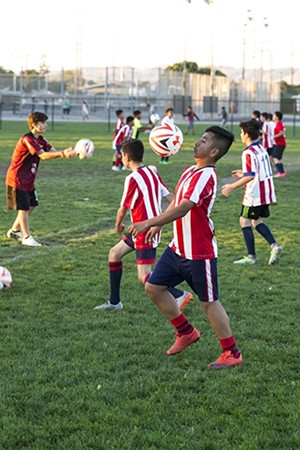
Surrounding those vast grounds are six half-court basketball courts, two water retention basins, a building with restrooms, and a 3,000-square-foot maintenance area, all separated by curving, connected veins of walking trails. More than 100 parking spots border the outer edges of the nearly 20-acre complex, and bushy trees are peppered throughout the animated park.
Another similar design from 2011 shows Waller Park, but with 60 acres of soccer and baseball fields and 600 parking spots, all connected by a centrally located event center.
The images, both conceptual designs created for local government agencies, are examples of two of the several failed attempts made by the city of Santa Maria, Santa Barbara County, and individual community members to make soccer fields more available in the area. Despite pleas from parents of young soccer players, among other residents, who say accessibility to athletic programs is key to preventing youth violence, major financial setbacks have halted Santa Maria’s development of further fields in almost every instance.
According to some longtime residents, Santa Maria’s lack of high-quality soccer fields has remained an unsolved issue for more than two decades, and with the increasing popularity of year-round club sports, the need for more parks to play on is only growing.
Sports over violence
It was an uncharacteristically warm fall evening on Oct. 25, about 20 degrees higher than normal, Atkinson Park was still swarming with soccer players of all ages. The park, although it was filled to capacity that night, is fairly roomy compared to others. It has a long expanse of well-maintained grass for soccer players, tennis and basketball courts, and a playground. And unlike many parks in the area, Atkinson has stadium lighting, a benefit for teams that practice after school during winter.
Teams from several age divisions of Chivas Soccer Academy, part of the Central City Soccer League, practice at Atkinson on Wednesday and Thursday evenings. Two or three teams from the academy usually share the main soccer field during practices, according to Charlie Alvarez, whose 16-year-old grandson plays with the academy. Teams from other leagues were crammed onto a small patch of grass near the playground.
Alvarez was one of several parents watching practice from the park’s bleachers, another of Atkinson’s amenities, and he said that with practices two times a week and games on Sundays year-round, kids who play league ball are too busy to get involved with gangs.
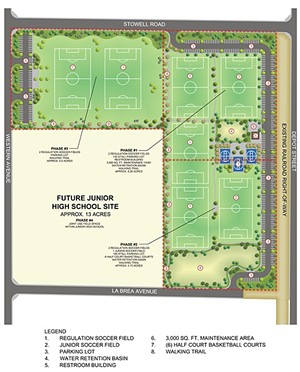
Youth and gang violence prevention has been a focus in Santa Maria since a series of gang-related murders shook the city in 2015. But as the Mayor’s Task Force on Youth Safety struggles to find attainable solutions to the city’s issue with violence, parents like Alvarez say increasing accessibility to year-round sports could be a simple step in the right direction.
“These kids are so tired by the time they’re done with soccer they barely have enough time to do their homework and go to sleep,” Alvarez said. “You won’t find any of these kids graffiti-ing or stealing your hubcaps. They’re tired. They’re ready to go home, study, eat, and sleep.”
Most kids who play league soccer also play for their school teams, Alvarez said, and in order to play school sports, kids have to achieve relatively high grade point averages. Studies are important, and Alvarez said the head coach of Chivas Soccer Academy, a teacher, offered to tutor the players in any subject. He’s also offered to help prepare older athletes for college through scholarship application guidance and SAT study groups.
That type of scholastic direction will be beneficial to team members like Alvarez’s grandson, Athos Veloso, who recently moved to Santa Maria from Brazil and speaks only Portuguese.
Although the Mayor’s Task Force has discussed sports as an alternative to youth violence, and the city’s strategic plan does list increasing sports involvement twice as an action that would prevent youth violence, the list is 107 action items long. Soccer, which school district and city officials said is Santa Maria’s most popular sport by far, isn’t mentioned in the plan. And at task force and Recreation and Parks meetings, various community members have said sports programs should be one of the city’s priority solutions.
“Little athletes like this, they hang around with other little athletes,” Alvarez said. “So there’s no attraction to gangs. These guys know who the gang members are and there’s just no attraction there because they hang around with each other and they’re sports oriented. That’s key. It really is key because you can get absorbed into these gangs very quickly.”
Flor Mota, the mother of 14-year-old Manuel Mota, echoed many of Alvarez’s opinions on soccer as a solution to violence. Mota said the kids who stop playing soccer sometimes take a turn for the worst, but her son has no problem avoiding trouble. All his friends are also his teammates, she said, so he doesn’t hang around with “gangsters and wannabes.”
“Which for us, as parents, it’s a blessing and it’s a relief,” Mota said. “Because you know you can trust most of these kids because they all have the same mindset. Soccer is on their minds all the time.”
That, she said, is worth the $80 fee she pays each month to be a part of the academy, a cost not all parents can afford.
But both parents said teams often struggle to find decent, affordable fields to practice on. The few fields that are open to the public are often riddled with gopher holes or deep divots, which can be dangerous for kids to play on, and others frequently flood during rainy months. Unlike many other areas in California, the Santa Maria Valley also lacks a space for large-scale soccer tournaments.
The absence of adequate soccer fields is present in much of northern Santa Barbara County, according to Mota, who commutes from her home in Lompoc to Santa Maria three times a week for her son’s soccer practices and games. She said Lompoc has similar issues: There are few fields, and the ones that do exist are poorly cared for.
Fielding needs
Thousands of kids are actively involved in Santa Maria’s various soccer leagues and school teams. There are roughly 1,000 kids of all ages, and more adults, enrolled in the Central City Soccer League alone, according to the league’s president, Juan Velasco.
But Velasco said the city hasn’t kept up with soccer’s growing popularity as a year-round sport. Coaches often struggle to find available fields for all the league’s teams on Sundays, Velasco said, which are game days for this particular league.
“And we just don’t have room for the kids,” Velasco said. “And that’s why you see a lot of kids wandering on the streets.”
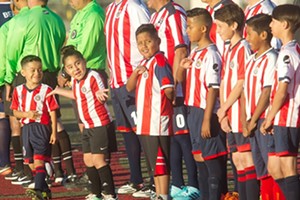
But Santa Maria does have fields.
Several leagues frequently use Adam and Crossroad basins and Atkinson Park for games on Saturdays and Sundays, according to Alex Posada, director of the Santa Maria Recreation and Parks Department. There are 12 other parks that teams typically use for practices, Posada said, including four that are used occasionally for games. Those fields each cost $10.50 an hour to rent without lights, and $22.50 with. But Posada said from November to February the field lights at Minami Park are turned on for free Mondays through Thursdays until 8:15 p.m.
The leagues also pay additional fees for games, Posada said, and Recreation and Parks develops different payment plans for each league based on its particular field needs.
Still, a Recreation and Parks commissioner said in a meeting on Oct. 10 that a needs assessment found the city to be 200 acres short of what the community needs for recreational field use. And Velasco said that many teams are forced to use school fields for practices and games, and the districts aren’t always helpful.
Schools sometimes lock the fences surrounding their fields, Velasco said, and when the fields are available, they’re often poor quality. A lot of schools never answer requests for use, Velasco said, and to top it all off, fields are expensive to rent. Velasco said the league typically pays $300 for a full day. And that, he said, is considered a reasonable price. Stadiums, which the league only rents for special events, are almost entirely unaffordable.
But Velasco said the Santa Maria Joint Union High School District (SMJUHSD) has made a real effort to help Central City Soccer League find space.
“Thanks to them the program is still going,” Velasco said. “Otherwise we wouldn’t be playing at all.”
SMJUHSD has three soccer fields, one at each of the district’s schools except Delta High School. Those fields are usually in use during the week, according to SMJUHSD Public Information Officer Kenny Klein, by the district’s various soccer and other sports teams, marching bands, and programs. The fields aren’t always open, Klein said, because the general public presents a liability issue for the district.
“Our sole mission is to educate kids,” Klein said.
But potential renters can fill out request forms to use the district’s grounds and facilities on weekends through plant managers, who oversee the rental process and monitor usage. To be accepted, Klein said an applicant’s event cannot conflict with school schedules and functions, the applicant must provide proof of insurance, and if approved, the rental fee must be paid.
The district bases its fees off the California Civic Center Act, a law approved by Gov. Jerry Brown in 2012 that establishes a consistent method by which school districts calculate fees for use of school facilities and grounds by outsiders. The calculation regulations went into effect in 2014.
The regulations allow SMJUHSD to set its own hourly rental rate based on how often an applicant plans to use the grounds and how much that use will eventually cost the district in maintenance, repair, restoration, and in hiring weekend personnel for security and janitorial services. Klein didn’t say specifically how much the district charges, but that its rates are currently being reviewed due to recent updates to the Civic Center Act.
Orcutt Union School District doesn’t charge outside groups for grounds use and doesn’t require an application or permit process, according to Assistant Superintendent of Business Services Walter Con. Con said the district has eight fields that can be marked and used for soccer, and they’re typically available outside of school hours on a first-come, first-served basis. Con said the district has a special agreement that prioritizes Orcutt United Soccer League, which enrolls hundreds of kids.
“Orcutt United Soccer League is the biggest soccer group in the Orcutt area,” Con said, “and we always have room for them on our fields.”
Still, the Orcutt Union School District can only support so many teams. Liliana Ramirez said fields were just as unavailable when her 11-year-old son played with Orcutt Arsenal Futball Club, a sect of the Orcutt United Soccer League. He now plays with Chivas Soccer Academy in Santa Maria.
“Same thing,” Ramirez said. “There weren’t enough places to practice. It’s been so sad.”
Parents and coaches seem to agree that a soccer complex would generally solve the issue of availability. Central City Soccer League President Velasco said he knows the city is trying, but he isn’t sure how hard.
“We really want these kids to have a place play,” Velasco said. “Most other cities have conferences and we don’t. But [soccer] is most popular here by far.”
Complex advocacy
It was a cloudless evening on Nov. 5 and a brisk breeze whispered through the stands in Santa Maria High School’s football stadium, where scores of soccer fans gathered for a once-in-a-lifetime opportunity to see a professional soccer team play live in Santa Maria.
A team of legendary professional soccer competitors who formerly played for Club Deportivo Guadalajara, a professional Mexican soccer club more commonly known as Chivas, came to play Santa Maria’s 1st Division adult league champions, the Red Devils. Tilon Chavez, a midfielder who played in a World Cup, and Omar Arellano, who scored two goals against the Red Devils, were among the many famous former Chivas players.
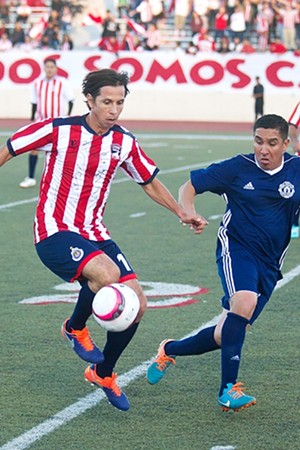
Despite the $20 tickets—all profits went toward hurricane recovery efforts in Puerto Rico, Florida, and Texas—the stadium’s stands were nearly full at the game’s start. Chivas fans wore red and white striped uniforms, and a ragtag group of musicians led energetic chants and songs.
Dozens of local children walked onto the field hand-in-hand with the legendary players for the game’s opening ceremony, and parents scurried from the bleachers to take photos and videos. The crowd cheered with equal vigor for each goal scored, and although the Chivas won 4-1, the Red Devils put up a good fight.
There were concessions and informational tables at the game, and one booth featured a petition for a soccer complex in Santa Maria. The petition was filled with pages and pages of more than 500 signatures at the beginning of the game, when supportive attendees were still filtering in through the gates.
Community members have been pushing for a soccer complex for years, according to Pete Flores, founder of One Community Action Coalition, a group working to support Santa Maria’s youth. Despite the birth of a Soccer Coalition, various meetings on the issue, and several plans for smaller-than-needed soccer complexes, Flores said, nothing has worked.
The master plan for a sports complex in Waller Park, approved by the county Board of Supervisors in 2011, was postponed for the still ongoing environmental document compilation and review process, according to Jill Van Wie, capital division manager of Santa Barbara County’s Community Services Department. But construction on the project, she said, won’t start until, or if, the county obtains $12.5 million to $15 million for the project’s estimated construction fees.
Similarly, construction on the planned Stowell Road sports complex was tabled this year after the city of Santa Maria was denied a $1 million grant from the state, which was integral to funding the project. A land-use agreement between the city and the owners of the property that would have held the complex is now in limbo, according to Recreation and Parks Director Posada.
That 20-acre complex, which would include seven soccer fields, would cost more than $3 million to build, Posada said. Funding, he said, is the major hurdle.
In an effort to continue the project, Posada said the city will apply for another grant in February through the state Department of Parks and Recreation in hopes of funding the complex. Another funding opportunity will arise in the form of Senate Bill 5, approved by Gov. Brown on Oct. 15, which Posada said will place a parks and water bond on the ballot in 2018.
But while funding is limited and the city’s most recent soccer complex plan is stalled, Posada said the city is working to find other temporary solutions. In a memo from Oct. 10 to the Youth Sports Field Committee, Posada wrote that the committee should further consider a list of previous options discussed in various meetings, including allowing portable lights during fall and winter months at additional locations and for expanded periods of time, thus allowing more teams to play later into the evening.
The city could also consider installing turf at the Simas Park softball field and expanding use of Elks Field, Posada wrote, providing more flexibility for both parks’ uses. Simas Park also has the added benefit of lighting.
Posada further suggested the committee take another look at the feasibility of the existing Waller Park sports complex plan and explore the placement of additional fencing around selected school play fields to provide permit-free access to outside programs without creating a liability concern for schools. Both those ideas, however, would require additional work with Santa Barbara County and the school districts.
The city hopes to continue improving communications between itself, community groups, and school districts, Posada said, which would help everyone know when and where grounds are open to the public. Still, he said school districts can’t be left alone to solve the city’s issue, and many of these options would just be stopgap measures to hold the city over until a complex can be built.
It’s simply difficult to keep up with soccer’s quickly growing popularity in Santa Maria, Posada said. And while sports were once seasonal, allowing time for the city to maintain and repair fields and facilities, almost all sports are now played year-round through various clubs and leagues.
But Posada said the city is aware of the issue and is quite willing to work to fix it. The Santa Maria City Council set field use as a priority issue in 2016, Posada said, and the Recreation and Parks Department was tasked with addressing the challenge.
“If kids can participate in sports,” Posada said, “the likelihood of violence is reduced.”
That sentiment is exactly why longtime Santa Maria residents like Arnulfo Romero, owner of Furniture and More and soccer representative for One Community Action Coalition, are pushing hard for a soccer complex. Romero said he constantly meets with the soccer leagues and associations to discuss their usage issues, one being that the leagues pay for fields then have to clean the grounds themselves.
Then Romero takes those complaints to meetings with the Mayor’s Task Force, City Council, and the Recreation and Parks Department. But his presence hasn’t been enough.
“We’re not getting to the right place,” Romero said. “We need a City Council member representing us. We need representation from Recreation and Parks, too. My goal is to work together. The goal is to have City Council and Recs and Parks with us.”
As the city works to find funding, Romero said community members are doing the same. Although the professional soccer game on Nov. 5 served as a fundraiser for hurricane victims, Romero said similar games could be used to raise money for a complex. One Community Action members will also travel to areas in Southern California where low-income communities were able to successfully build sports complexes.
“It’s a need, it’s really a need for the people of Santa Maria,” Romero said. “This would make Santa Maria less violent.”
Staff Writer Kasey Bubnash can be reached at [email protected].



